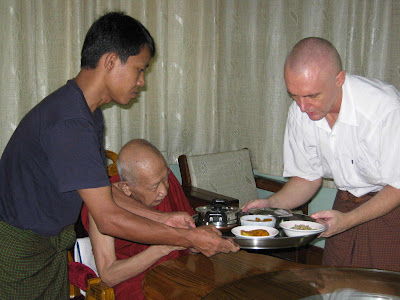The community at the monastery is preparing for an important meeting of senior monks (Thera) from the international network of forest monasteries (in the tradition of Ajahn Chah). This meeting is due to begin next week. I met briefly with the "Guest Monk" - who has the duty of anwering queries from temporary visitors such as myself. Ven. Nyaniko Bhikkhu told me he ordained at Abhayagiri Monastery in Redwood, California, United States seven years ago.
This trip helped to straighten out some misconceptions I previously held about Wat Pa Nanachat/International Forest Monastery and the international network.
I had previously assumed that the views of Ajahn Brahm from Bodhinyana Monastery in Perth, Australia and Ven. Sujato from Santi Forest Monastery, New South Wales, were representative of the entire forest monastery network. When living in Australia, I did not wish to visit either of these Australian monasteries due to controversial views expressed by Ajahn Brahm and Ven. Sujato. This was despite living close to both monasteries at various times during the past 15 years. Ven. Nyaniko told me that both Ajahn Brahm and Ajahn Sugato have chosen to leave the network for the time being. I did not pursue the details of this break nor ask questions about what may be the cause etc. I found out belatedly after returning to Bangkok. It seems that Ajahn Brahm and Ven. Sugato may have hurt the network as a whole. Maybe one day they may both reconsider their views, apologise and return to the network.
I felt relieved to hear that the forest monastery tradition is open to many different Buddhist meditation practices including Mahasi method vipassana.
I also apologised to Ven. Nyaniko for previously considering Ajahn Chah monks to be overly obsessed with vinaya (monk's disciplinary rules) and the outward appearance of monastic life with insufficient focus on meditation and spiritual attainment. I realised many years ago that this was incorrect and was glad to be able to apologise face to face with Ven. Nyaniko as a representative of the Ajahn Chah lineage. Another reason for relief.
Wat Pa Nanachat has a very peaceful atmosphere and seems to be a delightful place to ordain and live the monastic life. I visited on Tuesday morning and spoke with Ven. Nyaniko and again on Wednesday morning to donate flowers, fruit and soy milk. It was Uposotha day on Wednesday so I undertook 8 precepts and listened to a wonderful Dhamma talk in Thai by Ajahn Jayasaro, who appears in many excellent videos you may download from Dhammatube. The talk was about the four divine abodes:
- Metta - loving-kindness
- Karuna - compassion
- Mudita - sympathetic joy
- Upekkha - equanimity
On Monday evening, I left Bangkok on an overnight train and arrived in Ubon Ratchathani on Tuesday morning (yesterday). I began writing this at an Internet cafe in Ubon near the Warin Markets. The returning train departed Ubon around 18:30 Wednesday evening and arrived in Bangkok around 06:00 Thursday morning. I paid for second class air con. sleeper, lower bunk. It is fairly comfortable though if the bed was another 10cm longer it would be a better fit. I stayed last night at the Pathumrat Hotel. I booked it via Agoda and got a big discount. The room was very comfortable and way above my usual standard of accomodation. I had air con. TV, ensuite, a fridge and so on.
At the Ubon train station just before boarding, I met Brian Johnson, a fellow Dhamma tourist, who had just finished a 2 or 3 week (not sure of the length of time) period living at Wat Pa Nanachat. I didn't notice him when I was there. He is a few months older than me and we boarded the train and swapped stories about our Dhamma experiences. It was one of those rare moments when I felt as though I'd met a long lost brother. We talked fast and four hours passed quickly before a train official said it was time to sleep and go to our separate carriages. I hope to meet Brian again one day or at least to have e-mail contact from time to time. Brian has a website with useful information about the teachings of Ven. Pa Auk Sayadaw. I encourage readers to check it out. www.paauk.org I promised Brian I would post an article about Dhammanusari and Saddhanusari before I fly to India on 3 December.







